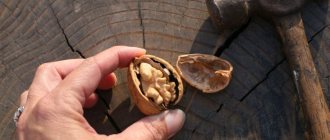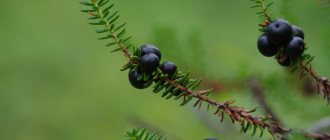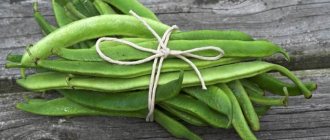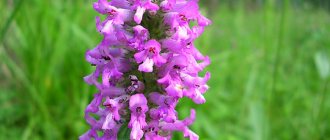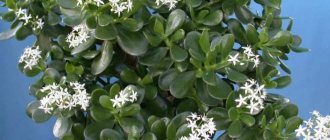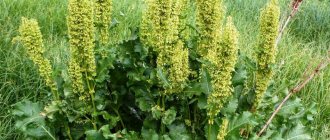One of the underestimated plants today is the blackthorn. Often people, having noticed the growth of this amazing, and most importantly medicinal shrub on their site, for some reason strive to get rid of it faster. For them, this is an ordinary weed and no benefit can be expected from it, but in this, as it turns out, they are deeply mistaken.
One of the most underestimated plants today is the blackthorn.
Many peoples glorify it as a sacred tree for its thorns and resistance to external adversity. Many people have a tradition of planting this plant near the house or hanging a branch above the door in order to scare away evil spirits. And according to the beliefs of the Romans, it is capable of protecting the house and its household from misfortunes and adversity.
Since ancient times, the thorn bush has been considered a very valuable plant, and not only its fruits are useful. To prepare a variety of medicinal tinctures and decoctions, people used roots, stems, leaves, flowers and young shoots.
Thorn in the country - plant or get rid of
Adding an article to a new collection
There are many plants that some summer residents dream of, but cannot have on their property, while others struggle with them and cannot drive them away from their territory.
Such controversial crops include thorns. Thorn, or blackthorn, or prickly plum - all these are names of the same plant. It can be either a shrub or a small tree. The thorn bush usually does not exceed 4.5 m; the tree can reach 8 m in height. The main distinguishing feature of the culture is the presence of a large number of thorns. It was the thorns that gave the bush its name: in the Proto-Slavic language, “thorn” is “thorn.”
Contraindications
However, thorn bushes are not as useful a product as experts believe. According to some, the harm of this product is negligible, however, according to others, thorn is a plant that slows down the metabolic process in the body, which has a detrimental effect on human health and its general condition. And if you take teren on an empty stomach, it can result in severe diarrhea.
Leading experts are convinced that if you abuse the tincture made from thorns, the body will begin a process of metabolic disturbances, which leads to dehydration and gastrointestinal disorders.
For people suffering from stomach diseases, gastritis or ulcers, eating thorn fruits is contraindicated, since teren is a berry characterized by its astringency and high acidity.
Some may experience allergic reactions after using this medicinal plant. Such consequences can also arise from pollen from flowering shrubs.
It is important to know about some rules for eating bush berries. You can eat them without seeds, just the pulp, since it is known that the seeds contain poison that is unsafe for human health. Therefore, they can be stored in canned form for no more than 12 months.
Thorn on the site: pros and cons
Thorn is a very controversial plant. There are summer residents who would never agree to have this thorny bush on their property. There are several reasons for such dislike:
- Thorns. Sharp thorn needles can cause injury. This is especially true in families with small children.
- Fruit. Both their size and taste are not very attractive to summer residents. Small - only 12 mm - drupes have a sour taste. Another drawback is their strong astringency.
- Collection. Harvesting is not easy. Dense bushes and branches covered with thorns make this work extremely difficult.
However, we must give the blackthorn its due: it also has many advantages.
- Unpretentiousness. Sloes can grow anywhere and in any conditions. He is not afraid of frost, drought, or infertile soils.
- Harvest. The absolute unpretentiousness of the bush allows you to get a large harvest every year, regardless of weather conditions.
- Hedge. Sloe bushes can be used to make hedges because they tolerate pruning easily and recover quickly from it.
- Protection. Thanks to its thorns, the blackthorn becomes an excellent protector and protects the area from uninvited guests.
How to care for thorns
More than a century ago, the famous breeder Ivan Michurin developed several varieties of a hybrid of plums and sloe - damsons. However, for some reason he called them thorns: dessert thorn and sweet thorn. Later, Thorn large-fruited and Thorn superabundant also appeared. Unlike traditional thorns, these trees do not have the main disadvantages of shrubs: hybrids have almost no thorns, and the fruits are sweet and not so tart. Nowadays you can find both sloe and damson trees in summer cottages.
Both cultures are equally unpretentious to growing conditions. They are able to withstand both extreme heat and frost down to -40°C. They can grow even in alkaline soils. They feel equally good in sunny areas and in the shade.
The sloe will bear fruit well even on poor soils. However, if you feed it once every few years with complex mineral fertilizer, the harvest will be more abundant. In addition, thorns that are not used for hedges or cut need sanitary pruning from time to time.
Description of the thorn
This is a shrub capable of reaching 4 meters in height. Under some circumstances, the plant reaches greater heights, so it looks like a tree. Its branches are very massive and they mainly grow in a horizontal direction. Most of the branches of the thorn are endowed with thorns, so it is often popularly called prickly plum or black thorn.
Teren is distinguished by its high resistance to any environmental conditions. He, unlike his brothers, is not afraid of even the most severe frosts.
The leaves of the blackthorn are oval-shaped and endowed with a bright green color, and the fruits are small round blue berries.
Many people have a tradition of planting this plant near the house or hanging a branch above the door in order to scare away evil spirits.
Blackthorn is a plant that often blooms in March or April. What’s most interesting is that its flowers bloom even before the leaves appear.
As for the fruits, the berries of this unusual but useful plant are very sour in taste and have some unusual viscosity. That is why this fruitful shrub is not among the berries preferred by people. However, the “unloved” taste and aroma of blackthorn is compensated by its invaluable and enormous benefits for the human body.
The main places where you can most often find blackthorn are the western regions of Siberia, Ukraine, Moldova, and the Caucasus. Ideal conditions for the growth of blackthorn are in dry rocky areas, forest edges, ravines or roadsides. The shrub is found even in some European countries, Iran, northern Africa and Asia Minor.
How to plant sloe in the garden
Sloes and damsons can be propagated in several ways:
- Bones. They are removed from the pulp of a ripened fruit in the fall, freed from the pulp and planted in open ground. The planting depth is small - only 6-7 cm. The planting site must be covered. When shoots appear, remove the protective layer and leave the seedlings to grow. After 2 years they can be planted in a permanent place.
- Cuttings. Propagation by cuttings should be carried out in the spring. Cut the cuttings, each of which should have at least 5-6 buds. For rooting, place them in small greenhouses (or cover with a transparent jar or bottle on top). During the summer, maintain a constant level of humidity inside the shelter. By autumn, cuttings with a developed root system can be planted in a permanent place in open ground.
- Root shoots. In the spring, carefully separate the shoot from the mother plant and plant it immediately in a permanent place. Care consists of regular watering and feeding with a nutrient solution.
When planting seedlings in a permanent place, pay attention to the size of the planting hole. It depends on the root system of the plant, but must be at least 60 cm in diameter. The distance between seedlings is determined by the size of the thorn or damson: at least 1 m for bushes and about 3-4 m for trees.
The thorn grows very quickly. If you don’t want to end up in thorn bushes one day, take care of this at the planting stage. Dig a limiter around the perimeter of the planting hole that will control the growth of roots. Sheets of slate or roofing felt can be used as a limiter.
Related article: Rebutia cactus: home care, photos, types and reproduction
Reproduction of damsons
To preserve the characteristics of the cultivar, planting seeds is not suitable. But if you need a hedge, you can dig the fruits into the ground. After 1-2 years, new growth will appear in their place, which will grow stronger within 3-4 years. If the seeds are germinated in advance, the seedlings will sprout within a year. For the winter, it is better to mulch the plot - preferably with spruce branches or fallen leaves, pressing it down with roofing material. In the spring, the seedlings are watered, fed, and weeded. After 2 years, you can plant them 1.5 m apart, or leave them in place.
A reliable method of propagation is cuttings. The branches are cut so that each has 4 growth buds. In the spring, the cuttings are planted in soil with a nutritious soil mixture and wait for roots to form. In autumn it can be transferred to open ground.
You can separate the root shoots by cutting them off from the main bush with the handle of a shovel. When planting, maintain a distance between holes of at least 1-1.5 m.
Useful properties of thorns
The fruits of thorns and damsons appear only in late August - early September. Their size depends on the variety. Due to their astringency, sloe fruits, unlike damsons, are almost never used as fresh food. Otherwise, their application is not much different from each other. They make jam, wine and kvass. Some housewives add the fruits of these plants to first and second courses. Thanks to the acid they contain, they add sourness to food.
Not only the fruits of the thorn are useful, but also its leaves. The amount of vitamin C in them is greater than in currants. For this reason, they make healthy vitamin tea.
Healthy recipes
Teren, whose beneficial properties and contraindications are a pressing issue for many people and experts, still has more advantages than disadvantages. There are several wonderful recipes for preparing damsons, after trying which a person will love this berry.
Tea made from the berries of the bush is very popular among blackthorn lovers. The fruits are collected in the fall, dried, then lightly fried, after which they are crushed to form a powder. To prepare a delicious drink, use 3 parts of regular tea leaves and 1 part of the prepared mixture.
Sloe kvass is no less popular. To prepare it you will need 1 kg of thorn fruit, about 8 liters of water, 1 glass of honey and approximately 30 g of dry yeast. It is necessary to keep the fruits for 24 hours at a temperature of 18-20ºС. Then they are crushed and filled with water. The mixture is placed on the stove and boiled for 40 minutes. After the entire procedure, you need to strain the prepared mixture and add honey and yeast. The fermentation process takes about 12 hours, after which it can be used as an invigorating drink.
And yet this berry, teren, is of great interest, the benefits and harms of which have forced many researchers in this area to stand on opposite sides of the barricades. However, these disagreements do not stop a person from using the fruits of this miraculous plant in moderation and always remaining healthy and filled with enormous strength and energy.
How to remove thorns from the site
If you are determined to remove the thorn from the site, then you will have to work hard. Sometimes it can take several years to fight it. To quickly solve the problem, the war against thorn bushes must be started on all fronts, in a comprehensive manner.
- Dig all the bushes as deep as you can. Bare the remaining roots.
- Sprinkle a thick layer of salt over the roots and the soil around them.
- Water the tree trunk circles with any herbicides that can help in the fight against shrubs. Roundup, Tornado, etc. are suitable.
- Cover as much of the area as possible with black film. It will deprive the roots of access to light - the main factor in the development of all plants.
- When new shoots appear, destroy them immediately and do not allow them to grow and develop.
We tried to introduce you to the positive and negative sides of the turn. Whether you leave this unpretentious shrub on your site or get rid of it completely is up to you.
What are the benefits of blackthorn?
Apart from the seeds, all parts of the prickly plum are considered beneficial. Aromatic tea is obtained from leaves and flowers. The berries are used to make marmalade and jam, jelly and jam, jelly and compotes, juices and alcoholic drinks. And the Bulgarians dry the fruits of blackthorn and add it to porridge. The bark and roots of the shrub are used as a diaphoretic and antipyretic.
Medicinal properties of blackthorn
Pleasantly astringent sour blackthorn berries have astringent properties and are a natural antibiotic, therefore they are an excellent assistant in the fight against various infectious diseases of the gastrointestinal tract, including those caused by Giardia.
Sloe wine is also considered an excellent medicine for infections in the intestines. And the sour taste increases appetite. The petals of thorn flowers have a laxative, diaphoretic, expectorant and diuretic effect.
Using their decoction you can calm the nervous system, reduce nausea and stop vomiting. Rinse your mouth with a decoction of flowers and you will forever forget about inflammation of the mucous membranes and throat diseases. Tea made from young thorn leaves will help heal wounds, pustular diseases, and boils. When taken orally, it will help solve problems such as edema and kidney stones. Constipation, cystitis and colitis will also disappear from your life if you drink tea from the leaves. This tea is also useful for men, as it solves such a delicate problem as prostate adenoma. Bark and roots - will quickly lower the temperature during viral diseases and influenza, malaria and infections.
Leucorrhoea? Sprinkle with bark decoction. Erysipelas goes away if you make lotions from the upper layers of the bark or compresses. Sloe is often found in modern medicines, as it has such effects as a laxative, expectorant, antibacterial and anti-inflammatory, and a strong diuretic. Liver problems - then fresh juice will help. It is also effective for skin diseases.
Thorn bush: planting and care, photo, pruning, propagation, properties - harm and benefit
Blackthorn, or blackthorn for short (Prunus spinosa), is a low shrub with thorns on its stems that belongs to the genus Prunus. For this reason, it is called prickly plum. The origin of the name is associated with the ancient Slavic language; in translation, thorn means “thorn”. Blackthorn grows in temperate latitudes, preferably on forest edges or in steppes, forming continuous and impenetrable stands. In the Crimea and the Caucasus, thorns are found high in the mountains. Under natural conditions, prickly plum thickets are common in Western Europe, northern Africa, Siberia and Asia Minor.
People learned about the thorn tree during the reign of Ancient Greece and Rome. In Christian teaching, thorns symbolize the suffering of God's son, Jesus. Even on the pages of Holy Scripture there is a mention of the thorn bush.
Description of the thorn bush
The thorn bush is capable of reaching a height of 3.5 to 4.5 m. Thorn trees grow up to 8 m. Dense basal shoots create a wide, branched and prickly crown, making the plant quite difficult to approach. The main root is buried almost a meter into the ground, and the rhizome can extend beyond the circumference of the crown. The stems of thorns are covered with thorns. The length of the leaves is no more than 5 cm. The shape of the leaf blades is ellipsoidal, the edges are serrated. The snow-white flowers are arranged singly. Flowering begins in the spring before the first leaves appear. In place of the flowers, purple fruits are formed, covered with wax and resembling a plum. The taste of damson berries is tart and sour. Their diameter does not exceed 12 mm.
The shrub bears fruit only when it reaches two or three years of age. Sloes demonstrate resistance to drought and are considered an excellent honey plant. Even an inexperienced gardener can plant a plant and then care for it. In gardens, blackthorn is planted as a hedge. As they grow, the branches of the bush reliably protect the slopes from landslides. For decorative purposes, the following varieties of thorns are used: purple, red-leaved and terry.
Planting thorns in open ground
Best time to plant sloe
The optimal time for planting sloe in open ground is early spring. However, the preparation of the planting hole is carried out in the fall. Thanks to this, the soil will settle well and compact. Sloes survive in saline and infertile soils and withstand spring floods. At the same time, heavy and waterlogged substrates often cause frostbite in the root system.
The most suitable area for planting sloe is an open space in the garden with nutritious neutral soil.
How to plant a thorn correctly
The walls of the dug hole are covered with slate or pieces of old iron, which will protect neighboring plants from growing damson branches. Before lowering the seedling into the hole, the bottom is sprinkled with crushed eggshells, which were collected over the winter. Then fill the hole with soil consisting of humus, superphosphate and potassium fertilizer. Soil with an acidic environment is diluted with lime. Seedlings are placed at intervals of 2-3 m from each other.
For planting material, choose strong and healthy bushes. The roots are pre-treated with a sodium solution. A stake is placed at the bottom of the hole, soil is evenly distributed around it and a seedling is placed in the center. The roots are leveled and covered with a fertilized substrate mixture so that the root collar protrudes above the surface by at least 3 cm. The boundaries of the tree trunk circle are marked with a kind of edge. This method allows you to retain moisture and prevent water from spreading during watering. Each bush requires about 2-3 buckets of water. After moisture is absorbed, the area where the sloe will be grown is mulched with humus, which prevents the moisture from quickly evaporating. The seedling is tied to a peg.
It is better to trim thorn branches after planting thorns. The next year, with the arrival of spring, they do sanitary and formative pruning of the bushes.
Rules and nuances of planting and caring for plants
The bush is planted at the beginning of spring, but preparation of the planting site begins in the fall. This is due to the fact that the soil will settle sufficiently during the winter and become stable.
Thorn grows best on clayey, saline, dry and sandy soil. Spring melting does not affect the condition of the prickly hedge, but you should not allow moisture to stagnate. To do this, you will need to equip soil drainage.
It is recommended to plant young plants on soil that is not weighed down by the abundance of water. Too wet soil will cause frostbite to the seedlings.
It develops well in illuminated fertile areas with neutral soil composition.
The depth of the dig is approximately equal to its width and is 60 centimeters.
The root system is prone to profuse growth, so its size will need to be controlled. To ensure regulation of the root size, at the planting stage it is necessary to lay sheets of iron, slate or other artificial durable material on the sides of the holes.
Planting is carried out in the spring. Beforehand, about 7 days before planting begins, a layer of eggshells must be laid on the bottom of the excavated space, which is covered with a mixture of local soil, superphosphate, compost and fertilizer. A distance of 1.5 meters is maintained between the bushes.
Planting material is purchased when it is 2 years old and must be prepared before work. For this purpose, the root system is immersed inside a mixture of half a bucket of clean water with 3-4 tablespoons of sodium humate.
The free space around the trunk is fenced off with an earthen border about 10 centimeters high. Next, you need to water the bush abundantly, using 20 to 30 liters of water.
To reduce the frequency of wetting of the bushes, a layer of mulch is laid on the surface of the ground.
Immediately after immersion into the soil, the bushes shorten the stems. Sanitary pruning, shaping haircut - everything is carried out with the onset of spring, but before the first buds swell.
Vegetation does not require careful care. Quite systematically:
- carry out watering;
- loosen the soil around the trunk;
- apply fertilizers;
- pull out weeds;
- remove excess growth from the roots;
- carry out mechanical processing.
Blackthorn propagation is carried out by seed or vegetatively. Growing plants from seeds is a very time-consuming and labor-intensive process. To speed up the process of creating a green fence, preference should be given to the vegetative method.
It is also possible to propagate the bush through root shoots or cuttings. Cuttings are selected based on the presence of at least 5 healthy buds. In spring they are planted in containers with fertile soil. Next, the container with seedlings is covered with a transparent cloth or transferred to greenhouse conditions. All summer you will need to regularly water the seedlings and apply fertilizer. Already in the fall, such cuttings will develop into full-fledged planting material, with a stronger root system.
The plant loves good access to sunlight, which is very important for abundant fruiting and flowering of the bush. Has increased resistance to pests, with the exception of those sucking tree sap, such as aphids
The pest sucks out the cell sap of growing young growth and foliage, after which they turn yellow and lose their appearance. It is a very prolific species, which can greatly harm plantings. In order to get rid of aphids, it is possible to spray with a solution of acaricidal decoction
It has increased resistance to pests, with the exception of those sucking tree sap, such as aphids. The pest sucks out the cell sap of growing young growth and foliage, after which they turn yellow and lose their appearance. It is a very prolific species, which can greatly harm plantings. In order to get rid of aphids, it is possible to spray with a solution of an acaricidal decoction.
The fruits of the plant are included in medications, however, there are contraindications. The berries contain a lot of acid, so they should not be consumed by people with gastritis, ulcers or high acidity of the stomach. Freshly squeezed sloe juice is used to treat intestinal problems. A decoction based on its fruits is used as an anti-inflammatory agent for the gastric mucosa.
Video information about choosing and planting thorn bushes:
Caring for thorns in the garden
Caring for thorn shrubs is quite simple and even a novice gardener can do it. It is important to follow several rules: regularly water, feed the plant, loosen the soil, remove weeds, trim branches that are too thick, and cover the bushes for the winter.
Related article: How to get rid of flower midges in pots and indoor plants
Watering
Immediately after planting the sloe, the young bush will only need one watering per week, then watering is reduced. Only when the blackthorn begins to actively grow, the moisture supply is resumed. During the year, the shrub has enough natural rainfall, but if a prolonged drought occurs, two buckets of settled water are poured under the seedlings.
Feeding
For normal and abundant fruiting, it is necessary to feed the sloe with organic or mineral fertilizers once a season. Bushes that grow in the same place for a long time need to be fed first.
Trimming
Thorn pruning activities are carried out in the spring, before sap flow begins. Dried and deformed branches are removed. Blackthorn has a tendency to thicken, as a result of which the crown should be thinned out regularly. You can leave only five strong fruiting branches. The cup-shaped bush shape is most common for garden growing of sloe.
In autumn, pruning of plants is performed exclusively for sanitary purposes, in order to get rid of old and broken branches. This is done after the foliage has fallen and the thorn bushes are preparing for winter.
Sloe propagation methods
Sloes are propagated using seeds, cuttings or root suckers. The seed method is time-consuming. As practice shows, vegetative propagation is much more successful.
Propagation by seeds
In September, the fruit seed is separated from the pulp and placed in the soil. Planting is done in the spring after seed stratification. To make them germinate faster, the seeds are soaked in honey syrup for several hours. After this, they are planted in nutrient soil, deepening 6 cm into the ground. The plantings are covered with film to create a greenhouse effect. When a couple of healthy leaves appear, the cover is removed. After two years, the seedlings are ready to be transplanted to a new location.
Propagation by cuttings
For cuttings, select cuttings that have 5 healthy buds. With the arrival of spring, they are placed in a container filled with fertile substrate, lightly covered and transferred to the greenhouse, trying to ensure constant watering and fertilizing. After 3-4 months, the cuttings take root.
Reproduction by offspring
The root shoots are carefully separated from the main bush, after which they are planted in shallow holes. It is better to maintain an interval of at least a meter between individual copies.
Diseases and pests of thorns
Thorn shows resistance to various diseases and pests. Cases of moniliosis are rarely observed. The cause of this fungal disease is monilia spores, which penetrate the calyx of the flower and infect young branches. Signs of the disease are darkening of leaf blades and shoots. Over time, the plant dies completely, the foliage turns yellow and falls off. Fruiting is noticeably reduced, the surface of the drupes begins to crack, and the fruits rot. Treatment of shrubs with fungicidal preparations helps to cope with moniliosis fungus. It is recommended to use Horus solution. It is capable of destroying fungus even in the cold season. Other effective drugs in the fight against gray mold are Gamair, Rovral, Bordeaux mixture and copper sulfate. The preparation of solutions must be carried out strictly according to the instructions.
Dangerous pests also include aphids - insectivores that feed on plant sap and eat leaves, causing the leaves to curl and turn yellow. Aphids multiply quickly and seriously damage shrubs, transmitting viral infections to neighboring plantings. To destroy aphids, acaricidal solutions of Aktara or Antitlin are used. To consolidate the effect, the treatment is repeated.
Properties of thorns: benefits and harms
Useful properties of thorns
Sloe fruits contain a large amount of healthy sugars, acids, pectin and tannins, fiber, vitamin C, E, and mineral salts. Fresh or processed blackthorn berries can have an astringent effect. They are used in the treatment of diseases of the gastrointestinal tract, ulcers, dysentery, poisoning, and vitamin deficiency.
Wine made from thorn fruits is considered medicinal. It is recommended to add it to the diet for infectious diseases, kidney and liver pathologies, symptoms of neuralgia and metabolic disorders in the body. Eating blackthorn berries helps lower body temperature and is used as a diaphoretic.
Experts advise using the fruits and flowers of thorns if patients suffer from edema, cystitis or urolithiasis.
Blackthorn flowers contain unique components that have a mild laxative effect, heal wounds and skin rashes, and normalize the functioning of the kidneys and intestines. Decoctions and infusions of thorn flowers act as a diuretic and diaphoretic. Doctors prescribe decoctions for hypertension, shortness of breath and constipation.
Berry juice has antibacterial properties, which increases the body's resistance to various parasites. Taking decoctions of thorns relieves inflammation of the mucous membrane. Tea made from the leaves is a good laxative for constipation. Substances contained in plant tissues relax the muscles of internal organs and reduce vascular permeability.
Contraindications
Despite all its beneficial properties, blackthorn is contraindicated for people with gastritis and stomach ulcers. Sloe seeds are poisonous, and the berries can cause an allergic reaction in rare cases.
Miracle decoctions
Blackthorn is a “magic” shrub that can be used to prepare medicinal decoctions used to combat many human ailments.
Decoctions prepared from thorns perfectly cleanse the blood and have antitoxic properties. This is an excellent folk remedy that copes with various skin rashes. It is also subject to pustular rashes and furunculosis.
A decoction of sloe flowers is used as an option to cleanse the intestines and improve peristalsis.
By the way, wild thorn is a plant that contains all the necessary substances that act as a sedative on humans. Therefore, it is used to prepare healthy drinks that help with insomnia or neuralgia.
The decoction also has a positive effect in the treatment of diseases of the oral cavity, for example, inflammation of the gums or throat.
Sloe berries are widely used for making compotes, jams and liqueurs.
In order to prepare a miraculous decoction, it is necessary to prepare the flowers of the plant, previously dried. They need to be filled with boiled water in an amount of 0.5 liters. The mixture is placed on the fire and boiled for 5 minutes. The resulting decoction must be filtered, and you can drink it instead of tea several times a day.
The thorn bush, as already mentioned, differs from other medicinal plants in one special property - the ability to purify the blood. The bark of the plant is used for treatment. This decoction has an excellent effect in the fight against various female diseases.
To prepare a decoction, you need to take a small amount of dried bark, add water and put it on the stove. Boil the broth for 20 minutes. Use it several times a day.
Teren is a berry known for its high effectiveness against colitis, dysentery and food poisoning, which is why it is used most often in folk medicine. It is very rich in fructose and glucose. Also, blackthorn berries are saturated with a large amount of vitamins, especially vitamins P. Prepared blackthorn juice has an antibacterial effect.
One of the advantages of the berry is its ability to dull a person’s sudden feeling of nausea. Doctors recommend that pregnant women consume them in small quantities.
Sloe berries are widely used for making compotes, jams and liqueurs.
Thorn bush: planting and care, photo, pruning, propagation, properties - harm and benefit
This plant is popularly called differently: damson, blackthorn and even damson. In fact, most often it means an ordinary thorn - the one that is famous primarily for its thorns and ability to create completely insurmountable thickets.
poor, clayey, neutral, sandy, fertile, slightly acidic, medium fertility, loamy, sandy loam, alkaline
partial shade, direct sunlight, diffuse sunlight
What is a thorn? Sloe, otherwise known as Prickly Plum, is a dense, rapidly growing and very prickly shrub, extremely winter-hardy, drought-resistant and unpretentious. It blooms in April-May, even before the leaves bloom, and looks quite impressive at this time. The fruits ripen in July-August and remain on the branches until winter. Freezing is very beneficial for them: the astringency is lost and the taste significantly improves. Productivity is approximately 12-15 kg per bush. Harvesting the fruit is difficult due to the large number of sharp thorns.
Article on the topic: Indoor trees - features and choice; care for indoor trees: watering, replanting, fertilizing
Thorn is not particularly widespread as a fruit crop, and in vain: despite the peculiar taste, its fruits are truly medicinal. They are rich in vitamins (primarily ascorbic acid and vitamin P), their juice has antibacterial properties and is used to treat diseases of the skin, gastrointestinal tract and kidneys. Sloe berry compote is an excellent homemade preparation for the winter; it is tasty and perfectly supports the immune system. And homemade sloe wine is one of those undeservedly forgotten ancient recipes that are worthy of attention in our time.
The cultivation of sloe (damson) is mainly practiced to create hedges, successfully replacing traditional fences. The dense thorn bush is almost impenetrable, and its dense greenery looks much more aesthetically pleasing than a blank wall or an ordinary chain-link mesh. However, why not take advantage of the added benefit of growing thorns and harvest them?
Sloe recipes
You can prepare many dishes from blackthorn berries. Most often, wild plums are used to make jam, jam, and compote. The fruits make a delicious, invigorating wine, and the aromatic tincture is not inferior to it.
Because of their subtle, pleasant aroma, wild plum berries have become the basis for sauces served with meat dishes. Pickled sloe tastes like olives.
In combination with apples, blackthorn gives a new taste to compote and pie filling. It is important to follow a number of general rules suitable for preparing any wild plum dish:
- the berries must be ripe, even better if they are picked after the first frost - this will remove the excess astringency;
- To cleanse dust, debris, and soften the skin, fruits can be doused with boiling water;
- the punctured peel will allow the berries to soak in the sweet syrup;
- strong fire will turn the plum fruits into porridge, low fire will keep them whole;
- seeds from berries are easily removed after heat treatment for several minutes;
- Sloe fruit preparations are stored for one to two years, depending on the temperature.
Sloe jam can be prepared in several ways.
- Seedless jam. Wash a kilogram of ripe fruits, boil in a small amount of water over low heat for 10-15 minutes. Drain the water, cool the berries, then remove the seeds. Pour the wild plum with prepared syrup made from 1 kg of sugar and 1 glass of water, boil for 30-40 minutes over low heat, stirring constantly. Pour the prepared jam into warm jars.
- Jam with seeds. Wash a kilogram of ripe wild plum fruits, pierce the peel, place in a cooking vessel, sprinkle with 1 kg of granulated sugar, pour in 500 ml of water. Leave for 3-4 hours. Boil and cook the berries for no more than five minutes. Cool, boil again, cook again for 5 minutes. Before the second boil, you can add a handful of washed and dried cherry leaves to the sweet mixture. Place the jam in jars when cold.
Thorn tincture
A delicious tincture is prepared from sloe plums. To prepare an ancient drink you need 2 kg of blackthorn fruits, 1 kg of sand, 200 ml of boiled water, 1.8 liters of vodka. Wash the fruits thoroughly, place in a glass container, cover with granulated sugar, tie the neck of the vessel with gauze, place in a warm place for 25- 30 days.
Blackthorn liqueur prepares faster. It will require 4 kg of ripe seedless thorns, 3 kg of sugar, a glass of water. All ingredients are placed in a glass container, the neck is tightly tied with gauze, and the vessel is placed in a warm place. After fermentation begins, a rubber glove is pulled over the neck.
Sloe cultivation
Lighting . To get a good harvest, it is recommended to provide the plant with a well-lit place, since in the shade it blooms worse and bears less fruit.
Where to plant the thorn? Thorn is undemanding and can grow on sandy, clayey, dry and even saline soils, and easily tolerates spring flooding. Growing in heavy or waterlogged soils can lead to frost damage, but frozen thorns recover very quickly. In garden conditions, it is best to plant thorns in fertile, moist soil with a neutral reaction.
How to plant correctly? Sloes are planted in the spring, the site is prepared a week before planting. It is advisable to add compost or humus, urea, ash into the pit, and if the soil is highly acidic, add lime, then mix everything thoroughly. The distance between seedlings should be at least 2 m (for a hedge - 1.5 m), since the bush tends to grow strongly. You can plant thorn seedlings in slightly excess quantities, so that after they begin to bear fruit, remove the excess by choosing the strongest plants with the most delicious fruits. Fruiting begins in the third, less often - in the second year. Sloe fruits are formed mainly on spurs - short bouquet branches.
Chemical composition of sloe
Damson is a low-calorie product. In 100 gr. fresh and ripe fruit contains no more than 54 calories. The same amount of product contains:
- proteins - 1.5 g;
- carbohydrates - 9.4 g;
- fats - 0.3 gr.
In addition, the structural composition of the berry includes:
- pectins;
- cellulose;
- glucose;
- fructose;
- vitamin E;
- Apple acid;
- tannins.
The composition of prickly plum depends on the place where it grows. But the main components of the sloe plum remain unchanged. Sloe fruits are rich in nutrients. The berries contain:
- growth vitamin A (retinol);
- vitamin B1, responsible for carbohydrate metabolism;
- vitamin B2 (riboflavin) necessary for normal development;
- vitamin B3 (niacin) needed by the heart and blood vessels;
- vitamin C (ascorbic acid) that resists anemia and infections;
- youth vitamin E (tocopherol),
- a source of health and longevity, vitamin PP (nicotinamide);
- immune-strengthening beta-carotene;
- pectin substances that prevent cancer;
- energy sources monosaccharides and disaccharides;
- organic acids maintaining acid-base balance;
- tannins that ensure the functioning of the stomach and intestines;
- macroelements necessary for a person: potassium responsible for muscle function, bone-forming calcium, magnesium necessary for the nervous system, sodium regulating water balance, tissue-forming phosphorus;
- microelements ensuring the normal course of all biochemical processes: iron, copper, iodine, zinc, cobalt;
- digestible carbohydrates: starch, dextrins;
- polyunsaturated fatty acids that improve blood composition and strengthen blood vessels;
- fiber and dietary fiber that cleanse the intestines of toxins;
- vascular strengthening flavonoids;
- antiviral and calming coumarins;
- participants in biological and chemical processes - higher alcohols;
- nitrogen compounds supplying oxygen to organs and tissues;
- triterpenoids;
- steroid elements;
- anthocyanins;
- essential oil.
How to care for thorns?
Fertilizers for sloe. For abundant fruiting, complex mineral and organic fertilizers are applied annually to the tree trunk circles; it is advisable to mulch the soil surface. The older the plant, the more it needs additional feeding.
Blackthorn pruning. Sanitary and formative pruning is usually carried out in March. Sloes are very prone to thickening, so they need to be thinned regularly. In the bush version, it is customary to leave no more than four to five well-fruiting branches.
Of particular interest is the option of forming a bush like a bowl. To do this, in the first year, the above-ground part of the bush is pruned at a height of 30-50 cm. In the second year, when pruning, the most powerful shoots are left, located in a circle. They are cut to about 2/3 of their length in summer, which stimulates branching. In the future, shoots that are too long are shortened and branches growing deep into the bush are removed.
Numerous shoots may appear in the area where the sloe is planted. It is usually cut at the root or trimmed with a spade along with a piece of root.
Nutritional and medicinal properties of the culture
Planting and caring for the damson varieties considered should not be difficult even for not very experienced gardeners. The basic principles of cultivation are not much different from the rules for caring for garden plums, only expressed in a simplified form:
- Selection of planting material. Growing a tree can be started from a seedling, a seed, or by grafting onto a regular plum tree. The simplest and most effective way to plant damsons is, of course, to plant a ready-made seedling. When choosing a sprout, preference should be given to a two-year-old plant with a well-developed root system.
- Choosing a landing site. The damson plum is not at all picky about the soil; it only tolerates swampy and overly salty soils. But if possible, it is better to choose soil with low acidity or adjust it by adding lime. Another nuance is that planting should be planned with a diameter of 4-5 m per tree.
- Planting damsons. Planting is recommended in the spring. A hole is dug, 50 cm deep and 70 cm in diameter. You can lay drainage at the bottom using crushed stone and sand. Mix the soil with manure and ash. The seedling is placed in the hole, the roots are carefully straightened and covered with prepared soil. After planting, the root collar should protrude 2-3 cm above the ground level. The tree is watered abundantly, and mulching can be done.
- Fertilization and care of damsons. The young damson tree grows rapidly and additional fertilizer is not recommended. During this period, before fruiting begins, it is enough to loosen the soil and, if necessary, water. Trimming should also be done shallow, gradually forming the crown. Already 3-4 years after planting, with the beginning of fruiting, you can apply organic fertilizers or mineral complexes in spring and autumn. At this time, more serious pruning should be carried out, removing young pagons and forming a crown with 4-5 main branches.
The damson is resistant to diseases and pests, but can sometimes be affected by fruit rot, damson, and dwarfism. In such cases, the wood is treated with special means.
The fruits of damsons contain up to 10% sugars, about 12% organic acids, as well as biologically active pectin and mineral substances necessary for a full human life.
The fruits themselves and their processed products are often used for medicinal and preventive purposes, especially to improve the normal functioning of the stomach and intestines (especially with low acidity). Damon fruits and their processed products are contraindicated for people suffering from heartburn or increased acidity of gastric juice.
Damson plum is a subspecies of domestic plum, which belongs to the genus Prunus. From the name it is clear that not everything is so simple here - this is a natural hybrid of plum and sloe, and it turned out from the cross-pollination of these two crops in nature. Unlike the rather sweet domestic plum, the fruits of the damson plum have a somewhat astringent taste, thorns can be observed on the shoots, and the plant itself is quite resistant to frost.
Ternosliv, in contrast to the more familiar plum, is distinguished not only by increased winter hardiness, but also by drought resistance, can withstand temperatures down to -37°C and bears fruit completely without watering. It loves full sun, moist, loamy and well-drained soils, rich in nutrients and without excess moisture. As for acidity, neutral is most optimal for it (pH 6.5-7). Does not grow well in excessively dry soils.
Thorn is a completely unpretentious and hardy crop; it is a winter-hardy and drought-resistant plant. Its main “weakness” is good illumination of the area where it grows. It can also live in partial shade, but in this case flowering and fruiting will be less abundant.
The root system is located at a depth of up to 1 m, the roots are quite branched and extend far beyond the crown.
The soil should be with good drainage, fertile and moist, neutral in acid reaction.
Many gardeners recommend adding a layer of eggshells to the bottom of the planting hole.
An important measure for caring for thorns is the fight against young shoots. If it is not used for crop propagation, it must be removed regularly and carefully. This is done with pruning shears at soil level or cut down along with pieces of root.
Fruit-bearing sloe plants require additional feeding, so organic matter and complex mineral fertilizers are annually applied to the tree trunk circles, and then the soil surface is mulched. As the crop matures, the dose of fertilizer is increased.
How to propagate sloe
It is very easily propagated by root suckers: they are carefully separated from the mother plant and planted in holes according to the method described above. A somewhat more difficult task is propagating thorns by seeds. The seeds are removed from the fruit and planted either in autumn or spring, after preliminary stratification. The soil must be fertile. Shelter is required before seedlings emerge. At the age of two, young sloe plants are transplanted to a permanent place.
Propagation by cuttings and grafting is also possible (for varietal sweet-fruited forms). Sloe or plum seedlings are used as a rootstock.
Varieties of sloe and damsons
There are sweet-fruited sloe cultivars obtained mainly by hybridization with related fruiting plants. Strictly speaking, not every type of sloe can be called damson, but only those varieties that are obtained as a result of hybridization with cultivated plums. To obtain varieties with sweet fruits, thorns are crossed not only with plums, but also with other fruits.
Sometimes the word “sloes” refers to varieties of small-fruited domestic plums, but this is incorrect: sloe and damson plums are independent plants.
Currently, sloe varieties are represented by the following names.
Apricot sloe, a hybrid with black apricot. The fruits, weighing 11-12 g, ripen at the end of August, the pulp has a light apricot aroma and a pleasant taste.
Cherry plum, obtained by crossing with cherry plum. The fruits ripen at the end of August, weigh about 8 g, and taste sweet and sour. The variety is distinguished by abundant fruiting.
Cherry thorn has fruits weighing 5-6 g, tart and sour. The productivity of the variety is high.
The fragrant thorn bears fruits weighing 6-7 g, distinguished by a particularly pleasant aroma and delicate sweet and sour taste. Fruiting is not very abundant, ripening is early - in early August.
